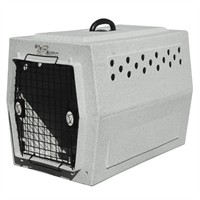
Crate Training Your Gun Dog
What's the Best Way to Crate Train your Gun Dog
When bringing home a new dog, one of the most important training tools is a crate. If you intend for your pet to live indoors, or if you plan to transport your gun dog for hunting excursions, a good crate can be one of the best investments that you make. Not only will a kennel keep your dog safe and out of harm’s way, but it will also aid in potty training and serve as a comfortable “den” for your pet to retreat to when he or she needs some space. Listed below are tips for crate training your gun dog.Choosing the Right Crate
Before you begin crate training, it is important to choose a crate that is right for the needs of both you and your dog. Look for a crate that will be large enough for your pet to stand up and turn around in, but not much larger. As den animals, dogs prefer small spaces, and a crate that is too large is inefficient for potty training. In addition, a travel crate should be small in order to minimize the risk of injury. A high quality, durable, and safe option for your pet is the Ruff Tough Kennel.
Look for a crate that will be large enough for your pet to stand up and turn around in, but not much larger. As den animals, dogs prefer small spaces, and a crate that is too large is inefficient for potty training. In addition, a travel crate should be small in order to minimize the risk of injury. A high quality, durable, and safe option for your pet is the Ruff Tough Kennel.
Start Slowly
When introducing your dog to the new crate, start slowly. At first, simply reward your pet for standing near the kennel. Never place your dog in the crate and assume that he or she will grow accustomed to it without additional training.Make Positive Training Associations
A crucial aspect of training is to ensure that your dog views the crate positively. After your pet grows accustomed to being near the crate, open the crate door and toss treats or a favorite toy inside. If your dog steps into the crate, provide plenty of positive praise. Over time, introduce the “kennel” or “crate” command when your dog walks into the kennel. Never use the crate as punishment for your pet, which will only cause him or her to detest or fear the kennel.Crated Meals for Your Dog
As your dog grows more comfortable being inside the kennel, begin to feed meals inside the crate with the door closed. Gradually increase the amount of time your dog is left crated after he or she has finished the meal, up to 30 minutes. Once your dog is comfortable with this final step, your pet is ready to be crated for extended periods of time, such as overnight or while you are away from home.Crate Release
When you release your dog from the crate, it is important that your pet does not go barreling out, especially if you plan to take your pet hunting in unfamiliar areas. Teach your dog a release command to avoid this potentially dangerous behavior. When you open the crate door, ask your dog to wait (you may have to physically restrain your pup in the beginning by holding his or her collar). When your dog is calm and not pulling against collar or trying to wriggle free, give the release command. Over time, your dog will learn not to exit the crate without your command.Read More - Tips for Choosing the Best Kennel for your Hunting Dog
Joe Scarpy - Owner / Trainer At HuntEmUp.com, we know sporting dogs. From the time they’re a puppy, through their senior years, we'll keep you informed on the latest news and information. For more information on Training, Preparing and Caring for your Dogs, read our Hunting and Sporting Dog blog.Join Our HuntEmUp.com Customer Club Today!
Join Our Customer Club and be entered in our Monthly Giveaway and a chance to Win products and more!
Join for FREE Today - Click Below to Get Started!



